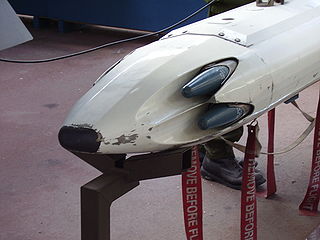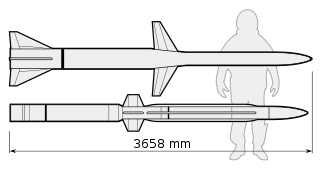
A missile is an airborne ranged weapon capable of self-propelled flight aided usually by a propellant, jet engine or rocket motor.

The AGM-114 Hellfire is an American air-to-surface missile (ASM) first developed for anti-armor use, later developed for precision drone strikes against other target types, especially high-value targets. It was originally developed under the name "Heliborne laser, fire-and-forget missile", which led to the colloquial name "Hellfire" ultimately becoming the missile's formal name. It has a multi-mission, multi-target precision-strike ability and can be launched from multiple air, sea, and ground platforms, including the MQ-1 Predator and MQ-9 Reaper. The Hellfire missile is the primary 100-pound (45 kg) class air-to-ground precision weapon for the armed forces of the United States and many other nations. It has also been fielded on surface platforms in the surface-to-surface and surface-to-air roles.

A multiple rocket launcher (MRL) or multiple launch rocket system (MLRS) is a type of rocket artillery system that contains multiple launchers which are fixed to a single platform, and shoots its rocket ordnance in a fashion similar to a volley gun. Rockets are self-propelled in flight and have different capabilities than conventional artillery shells, such as longer effective range, lower recoil, typically considerably higher payload than a similarly sized gun artillery platform, or even carrying multiple warheads.

The CRV7, short for "Canadian Rocket Vehicle 7", is a 2.75-inch (70 mm) folding-fin ground attack rocket produced by Bristol Aerospace in Winnipeg, Manitoba. It was introduced in the early 1970s as an upgraded version of the standard U.S. 2.75-inch air-to-ground rockets. It was the most powerful weapon of its class, the first with enough energy to penetrate standard Warsaw Pact aircraft hangars. The CRV7 remains one of the most powerful air-to-ground attack rockets to this day, and has slowly become the de facto standard for Western-aligned forces outside the United States. Beginning in 2021, 83,303 stored Canadian CRV7s are slated for disposal having been removed from service from 2005 to 2007. In 2024 the Department of National Defence is considering donating the rockets to Ukraine as military aid to defend against the Russian invasion of Ukraine. An estimated 8,000 rockets have functioning warheads while the remainder could be used for parts or modification.
The Hsiung Feng IIE is a surface-to-surface land-attack cruise missile system developed by the National Chung-Shan Institute of Science and Technology (NCSIST) in Taiwan.

The AIM-152 Advanced Air-to-Air Missile (AAAM) was a long-range air-to-air missile developed by the United States. The AIM-152 was intended to serve as the successor to the AIM-54 Phoenix. The program went through a protracted development stage but was never adopted by the United States Navy, due to the ending of the Cold War and the reduction in threat of its perceived primary target, Soviet supersonic bombers. Development was cancelled in 1992.

The Popeye is a family of air-to-surface missiles developed and in use by Israel, of which several types have been developed for Israeli and export users. A long-range submarine-launched cruise missile variant of the Popeye Turbo has been speculated as being employed in Israel's submarine-based nuclear forces. The United States operated the Popeye under a different designation according to US naming conventions as the AGM-142 Have Nap.

The Polyphem was a proposed European light-weight fibre-optic wire-guided surface-to-surface missile with a range of 60 km. The project was cancelled in 2003.

The 9K121 Vikhr is a Soviet laser-beam-riding anti-tank missile. "9K121" is the GRAU designation for the missile system. The missile can be launched from warships, Ka-50 and Ka-52 helicopters, and Su-25T aircraft. It was first shown publicly at the 1992 Farnborough Airshow.

The Kh-25/Kh-25M is a family of Soviet lightweight air-to-ground missiles with a modular range of guidance systems and a range of 10 km. The anti-radar variant (Kh-25MP) is known to NATO as the AS-12 'Kegler' and has a range up to 40 km. Designed by Zvezda-Strela, the Kh-25 is derived from the laser-guided version of the Kh-23 Grom. The Kh-25 remains in widespread use despite the apparent development of a successor, the Kh-38.

The LAHAT is a third generation semi-active laser homing low-weight anti-tank guided missile developed since 1991 and manufactured by Israel Aerospace Industries. It has a tandem-charge high-explosive anti-tank (HEAT) warhead. It was designed primarily to be fired by Merkava tanks' 105 mm and 120 mm tank guns, though it matches all types of 105 mm and 120 mm guns, including low recoil guns and low-weight guns of military armoured cars.

The AGR-20 Advanced Precision Kill Weapon System (APKWS) is a design conversion of Hydra 70 unguided rockets with a laser guidance kit to turn them into precision-guided munitions (PGMs). APKWS is approximately one-third the cost and one-third the weight of the current inventory of laser-guided weapons, has a lower yield more suitable for avoiding collateral damage, and takes one quarter of the time for ordnance personnel to load and unload.

The MAPATS is a laser guided, beam riding anti-tank guided missile (ATGM) developed by Israel Military Industries as a possible successor to United States' wire-guided missile, BGM-71 TOW. The MAPATS is sometimes nicknamed Hutra – an Aramaic word for stick.

The Direct Attack Guided Rocket (DAGR) is a weapons system under development by Lockheed Martin. The program goal is to provide a low cost 2.75 inch (70 mm) precision guided rocket which is compatible with existing Hellfire II systems and launchers in service. The system will use components from the existing Hydra 70 rocket, but differs from other upgrades to the Hydra 70 such as APKWS and LOGIR in that it is designed to be plug and play compatible with the Hellfire missile and use the M299 Hellfire launcher, increasing the load-out by up to four times. DAGR also offers a lock-on before launch capability that is not compatible with the electronics in existing Hydra 70 launchers.

The AGM-176 Griffin is a lightweight, precision-guided munition developed by Raytheon. It can be launched from the ground or air as a rocket-powered missile or dropped from the air as a guided bomb. It carries a relatively small warhead, and was designed to be a precision low-collateral damage weapon for irregular warfare. It has been used in combat by the United States military during the War in Afghanistan.

ALAS is a Serbian long-range multipurpose wire guided missile system developed by the private company EdePro and the state-owned Yugoimport SDPR. The ALAS missile system was developed primarily for missions against tanks, armored vehicles, fortifications, command posts, low-flying helicopters, coastal ships, industrial facilities and bridges. It can be deployed by any suitable platform including helicopters, armored vehicles, small ships and infantry. The guidance system is based on video/infrared technology, with the missile connected to the launcher by a fiber-optic cable. The ALAS flies at low altitude and has small radar and infrared (heat) signatures due to using a turbofan motor instead of a turbojet. In recent years, the ALAS platform has found a secondary use as a UAV.

A precision-guided munition is a guided munition intended to hit a specific target, to minimize collateral damage and increase lethality against intended targets. During the First Gulf War guided munitions accounted for only 9% of weapons fired, but accounted for 75% of all successful hits. Despite guided weapons generally being used on more difficult targets, they were still 35 times more likely to destroy their targets per weapon dropped.

Hermes is a family of modularly designed guided missiles developed in Russia by the KBP Instrument Design Bureau.
The Pike is a precision-guided mini-missile or grenade munition designed by Raytheon. It is a 40 mm guided munition that can be fired from the barrel of a Heckler & Koch M320 Grenade Launcher Module and Enhanced Grenade Launching Module (EGLM) like a standard 40mm grenade, but is powered by a rocket motor to propel it 2,000 m to give infantrymen improved extended-range precision capabilities. The weapon uses a digital, semi-active laser seeker to guide itself to within five meters of the target; it can operate in a two-man shooter/spotter team or by the grenadier alone lazing after firing, as it can fly for 15 seconds before homing in. When fired, Pike has a small propellant to "kick" it 2.5–3 m (8.2–9.8 ft) out of the tube before the nearly smokeless motor ignites, and range is dependent on firing angle. The munition is effective against fixed and slow-moving mid-range targets, using a 6⁄10 lb blast fragmentation warhead with a 10-meter lethality radius. Raytheon developed the weapon for three years in collaboration with Nammo Talley, which developed the warhead and propulsion system. The Pike is intended to be more accurate with a longer range than rocket propelled grenades (RPGs) and standard rifle grenades, while being far lighter and more cost-effective than current infantry guided weapons like the $78,000 each FGM-148 Javelin. Further improvements could include different fuses, multiple-round simultaneous programming and targeting with data-link capabilities, and platform integration onto small boats, vehicles, and small unmanned aerial vehicles (UAVs). Pike weighs 1.7 lb (0.77 kg) and is 16.8 in (43 cm) long, too long to fit in the breech of the M203 grenade launcher. At AUSA 2015, Raytheon revealed they had performed two successful test firings of the Pike.
Çakır is a new generation cruise missile that can be launched from land, sea and air platforms with a range of more than 150 km (93 mi), designed by Turkish rocket and missile manufacturer Roketsan. It was introduced with the launch of Roketsan Ankara Lalahan facilities on 31 March 2022. On the same day, a video about the missile was shared on the Twitter account of Roketsan.

















